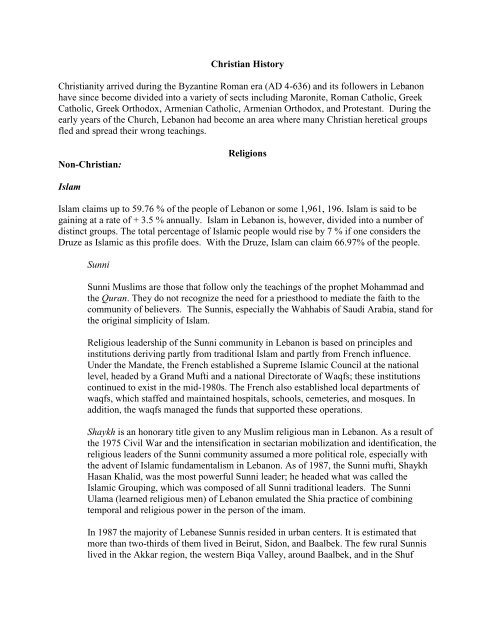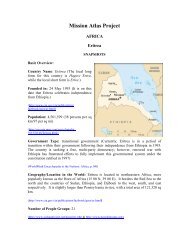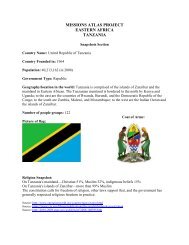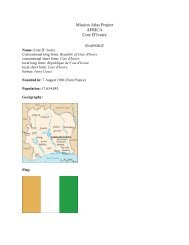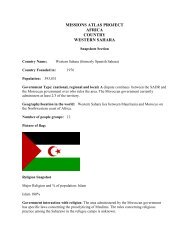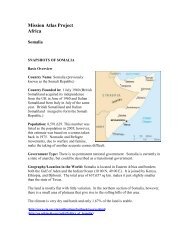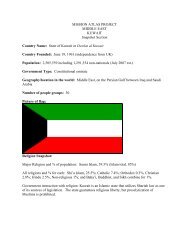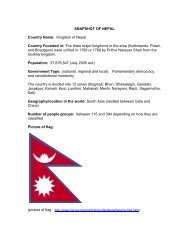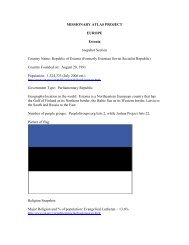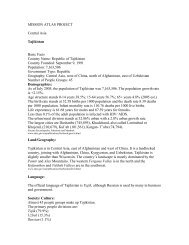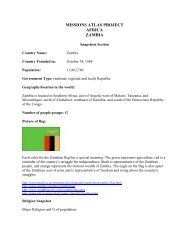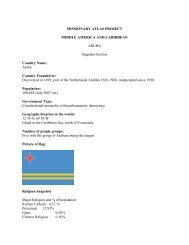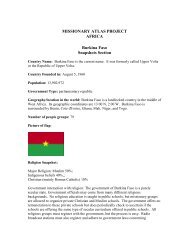Lebanon Profile.pdf - WorldMap
Lebanon Profile.pdf - WorldMap
Lebanon Profile.pdf - WorldMap
You also want an ePaper? Increase the reach of your titles
YUMPU automatically turns print PDFs into web optimized ePapers that Google loves.
Christian HistoryChristianity arrived during the Byzantine Roman era (AD 4-636) and its followers in <strong>Lebanon</strong>have since become divided into a variety of sects including Maronite, Roman Catholic, GreekCatholic, Greek Orthodox, Armenian Catholic, Armenian Orthodox, and Protestant. During theearly years of the Church, <strong>Lebanon</strong> had become an area where many Christian heretical groupsfled and spread their wrong teachings.Non-Christian:ReligionsIslamIslam claims up to 59.76 % of the people of <strong>Lebanon</strong> or some 1,961, 196. Islam is said to begaining at a rate of + 3.5 % annually. Islam in <strong>Lebanon</strong> is, however, divided into a number ofdistinct groups. The total percentage of Islamic people would rise by 7 % if one considers theDruze as Islamic as this profile does. With the Druze, Islam can claim 66.97% of the people.SunniSunni Muslims are those that follow only the teachings of the prophet Mohammad andthe Quran. They do not recognize the need for a priesthood to mediate the faith to thecommunity of believers. The Sunnis, especially the Wahhabis of Saudi Arabia, stand forthe original simplicity of Islam.Religious leadership of the Sunni community in <strong>Lebanon</strong> is based on principles andinstitutions deriving partly from traditional Islam and partly from French influence.Under the Mandate, the French established a Supreme Islamic Council at the nationallevel, headed by a Grand Mufti and a national Directorate of Waqfs; these institutionscontinued to exist in the mid-1980s. The French also established local departments ofwaqfs, which staffed and maintained hospitals, schools, cemeteries, and mosques. Inaddition, the waqfs managed the funds that supported these operations.Shaykh is an honorary title given to any Muslim religious man in <strong>Lebanon</strong>. As a result ofthe 1975 Civil War and the intensification in sectarian mobilization and identification, thereligious leaders of the Sunni community assumed a more political role, especially withthe advent of Islamic fundamentalism in <strong>Lebanon</strong>. As of 1987, the Sunni mufti, ShaykhHasan Khalid, was the most powerful Sunni leader; he headed what was called theIslamic Grouping, which was composed of all Sunni traditional leaders. The SunniUlama (learned religious men) of <strong>Lebanon</strong> emulated the Shia practice of combiningtemporal and religious power in the person of the imam.In 1987 the majority of Lebanese Sunnis resided in urban centers. It is estimated thatmore than two-thirds of them lived in Beirut, Sidon, and Baalbek. The few rural Sunnislived in the Akkar region, the western Biqa Valley, around Baalbek, and in the Shuf


